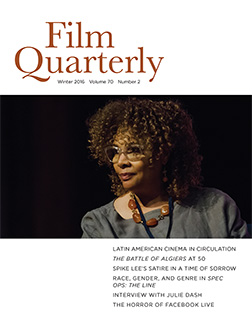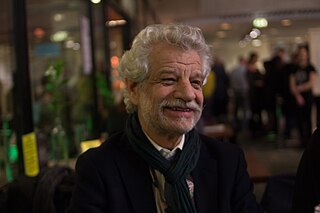Feminist film theory is a theoretical film criticism derived from feminist politics and feminist theory influenced by second-wave feminism and brought about around the 1970s in the United States. With the advancements in film throughout the years feminist film theory has developed and changed to analyse the current ways of film and also go back to analyse films past. Feminists have many approaches to cinema analysis, regarding the film elements analyzed and their theoretical underpinnings.

Kathy Acker was an American experimental novelist, playwright, essayist, and postmodernist writer, known for her idiosyncratic and transgressive writing that dealt with themes such as childhood trauma, sexuality and rebellion. Her writing incorporates pastiche and the cut-up technique, involving cutting-up and scrambling passages and sentences; she also defined her writing as existing in the post-nouveau roman European tradition. In her texts, she combines biographical elements, power, sex and violence.
Structuralist film theory is a branch of film theory that is rooted in structuralism, itself based on structural linguistics.

The Situationist International (SI) was an international organization of social revolutionaries made up of avant-garde artists, intellectuals, and political theorists. It was prominent in Europe from its formation in 1957 to its dissolution in 1972. The intellectual foundations of the Situationist International were derived primarily from libertarian Marxism and the avant-garde art movements of the early 20th century, particularly Dada and Surrealism. Overall, situationist theory represented an attempt to synthesize this diverse field of theoretical disciplines into a modern and comprehensive critique of mid-20th century advanced capitalism.

Guy-Ernest Debord was a French Marxist theorist, philosopher, filmmaker, critic of work, member of the Letterist International, founder of a Letterist faction, and founding member of the Situationist International. He was also briefly a member of Socialisme ou Barbarie.

Laura Mulvey is a British feminist film theorist and filmmaker. She was educated at St Hilda's College, Oxford. She is currently professor of film and media studies at Birkbeck, University of London. She previously taught at Bulmershe College, the London College of Printing, the University of East Anglia, and the British Film Institute.
Raymond Durgnat was a British film critic, who was born in London to Swiss parents. During his life he wrote for virtually every major English language film publication. In 1965 he published the first major critical essay on Michael Powell, who had hitherto been "fashionably dismissed by critics as a 'technician's director'", as Durgnat put it.

Cathy Lomax is a London artist, curator and director of the Transition Gallery. She is mainly known for her figurative paintings which often focus on the female image and are inspired by 'the seductive imagery of film, fame and fashion'.

James Lewis Hoberman is an American film critic, journalist, author and academic. He began working at The Village Voice in the 1970s, became a full-time staff writer in 1983, and was the newspaper's senior film critic from 1988 to 2012. In 1981, he coined the term "vulgar modernism" to describe the "looney" fringes of American popular culture.

Film Quarterly (FQ), published by University of California Press, is a journal devoted to the study of film, television, and visual media. When FQ was launched in 1945, it was considered "the first serious film journal in the United States, with those most interested in the subject at the helm."

Pam Cook is Professor Emerita in Film at the University of Southampton. She was educated at Sir William Perkins's School, Chertsey, Surrey and Birmingham University, where she was taught by Stuart Hall, Richard Hoggart, Malcolm Bradbury, and David Lodge. Along with Laura Mulvey and Claire Johnston, she was a pioneer of 1970s Anglo-American feminist film theory. Her collaboration with Claire Johnston on the work of Hollywood film director Dorothy Arzner provoked debate among feminist film scholars over the following decades.
Afterall is a nonprofit contemporary art research and publishing organisation. It is based in London, at Central Saint Martins. It publishes the journal Afterall; the book series Readers,One Works and Exhibition Histories.

Thomas Elsaesser was a German film historian and professor of Film and Television Studies at the University of Amsterdam. He was also the writer and director of The Sun Island, a documentary essay film about his grandfather, the architect Martin Elsaesser. He was married to scholar Silvia Vega-Llona.
European art cinema is a branch of cinema that was popular in the latter half of the 20th century. It is based on a rejection of the tenets and techniques of classical Hollywood cinema.

Chris Welsby is a Canadian experimental filmmaker, New Media and gallery installation artist. Born in the UK, in the 1970s Welsby was a member of the London Film-Makers' Co-op, and co-founder of the Digital Media Studio at the Slade School of Fine Arts, UCL, London. He immigrated to Canada in 1989. He is considered one of the pioneers of expanded cinema and moving image installation and was one of the first artists to exhibit film installations at the Tate and Hayward galleries London. His expanded cinema works and installations have since continued to break new conceptual ground and attract critical attention. A. L. Reece, in British Film Institute's A History of Experimental Film and Video, wrote: "Twenty-five years ago, when he made his first projections for large spaces, film and art rarely met in the gallery; now it is common and installation art is a distinct practice."
Denys George Irving, was a Welsh filmmaker and musician from Colwyn Bay, North Wales.
Riddles of the Sphinx is a 1977 British experimental drama film written, directed and produced by Laura Mulvey and Peter Wollen and starring Dinah Stabb, Merdelle Jordine and Riannon Tise.
The BFI Production Board (1964-2000) was a state-funded film production fund managed by the British Film Institute (BFI) and "explicitly charged with backing work by new and uncommercial filmmakers." Emerging from the Experimental Film Fund, the BFI Production Board was a major source of funding for experimental, art house, animation, short and documentary cinema, with a continuing commitment to funding under-represented voices in filmmaking.
Murray Smith is a film theorist and philosopher of art based at the University of Kent, where he is Professor of Philosophy, Art, and Film and co-director of the Aesthetics Research Centre. He is the author of three books and numerous articles on film and aesthetics, and the co-editor of three collections of essays. He was President of the Society for Cognitive Studies of the Moving Image from 2014 to 2017, and has served on the editorial boards of Screen, Cinema Journal, the British Journal of Aesthetics, Projections and Series. He has held a Leverhulme Research Fellowship (2005–6), and a Laurance S Rockefeller Fellowship at Princeton University’s Centre for Human Values (2017–18). He delivered a Kracauer Lecture in 2014 at the Goethe University Frankfurt, the inaugural Beacon Institute lecture in 2015, and the Beardsley Lecture in 2018, sponsored by Temple University at the Barnes Foundation.

Karola Gramann is a German film scholar and film curator. From 2006 to 2019 she was artistic director of the Kinothek Asta Nielsen e.V.










